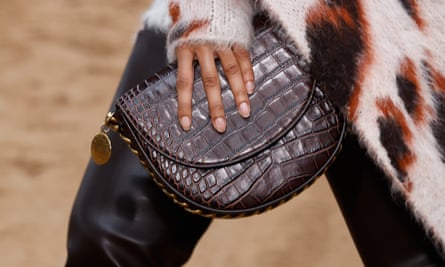Would you pay £350 for a bag made from scraps of leather swept up from a factory floor?
The American fashion house Coach is betting on it as a new concept to lure the next generation of luxury consumers. This week it launched Coachtopia, a sub-brand that focuses on circular craft and features a variety of bags made from leather that was originally destined for landfill.
Twenty years ago, the most desirable “it bags” were made from rare and exotic animal skins such as a crocodile Hermès Birkin, which fetched six-figure sums. Fast forward to 2023 and there’s been a sharp paradigm shift with a plethora of leather alternatives and a trend for recycling and upcycling existing animal leather. Price points have also dropped with the sweet spot hovering around the £200 mark.
Telfar’s vegan shopping bag dubbed the “Bushwick Birkin”, thanks to its popularity in New York kickstarted the trend. While still expensive, they aren’t extortionate. These “it bags” are less about flaunting about how much money you’ve got and more about humble bragging that IYKYK.
Last week, Ganni launched a bag made from the waste of orange and cacti farms, and Hermès has experimented with mushroom leather. “Every time you eat an apple, you’re basically eating a handbag,” quipped Stella McCartney after showcasing her latest collection in March, which included bags made from the waste of apples (pictured below) originally grown for juice and jam in northern Italy.
Volkan Yilmaz, a leather expert who deconstructs luxury leather goods to access their quality on his viral TikTok channel under the name Tanner Leatherstein, says the idea of animals such as cows, goats, pigs and sheep being bred just for their leather is a regularly misquoted fact. “It’s a byproduct of the meat industry. It’s one of the first examples of the up-cycling economy in history. As a meat eater, it’s more responsible of me to use leather.”
However, it cannot be denied that the animal leather industry is notoriously wasteful. According to engineered leather supplier ELeather, up to 75% of all leather hides are squandered. Research from the Leather and Hide Council of America found that in 2019 in the US alone over 5 million hides went to landfill.
Gen Z – those born between 1997 and 2012 – is driving the rebellion against the creation of even more animal leather. According to research from McKinsey, nine in 10 Gen Z consumers believe companies have a responsibility to address environmental and social issues while 54% of are open to spending 10% extra for sustainable products, a sharp contrast to baby boomers, of which only 23% were willing to.
Joon Silverstein, senior vice president for global marketing, creative and sustainability at Coach, says that according to the company’s research older generations and more established luxury consumers tend to consider pieces made from recycled leather as low quality. “Gen Z has a different mindset – they consider it a moral and ethical [issue],” says Silverstein.

Leather waste mainly happens at two stages – at the tannery, where hides are treated and processed into leather, and at the factory, where pieces such as bags are created from the treated hides.
Due to the chemicals used in the tanning process, not all leather is biodegradable, either. And while faux leather is regularly hailed as an eco or vegan alternative, many of these options – such as “pleather” – are made from materials that are plastic and petroleum-based and come with an array of environmental issues.
after newsletter promotion
While Coach hasn’t ruled out exploring plant-based options such as those championed by McCartney, Silverstein says the Coachtopia concept is prioritising the reduction of waste: “There is already so much that exists on this planet, so how about reusing that?”
The scraps are, says Silverstein, “very challenging to use because they are small, irregular, flawed, unpredictable and continually changing“. As a result, Coach’s design team had to shift their process from “forwards to backwards”.
And while the use of the word “scraps” isn’t usually adopted by luxury fashion houses, Silverstein is confident that its Gen Z consumers won’t be phased. She compares it to choosing a brand new plastic bottle over a recycled one from the same shelf.
Instead of sketching out what a perfect bag looks like and then sourcing the materials, designers have to work with what materials the company already has. Says Silverstein: “It’s not about wanting perfect or ideal colours. You get what you get.”
If you want to read the complete version of this newsletter please subscribe to receive Fashion Statement in your inbox every Thursday
Stay connected with us on social media platform for instant update click here to join our Twitter, & Facebook
We are now on Telegram. Click here to join our channel (@TechiUpdate) and stay updated with the latest Technology headlines.
For all the latest Lifestyle News Click Here
